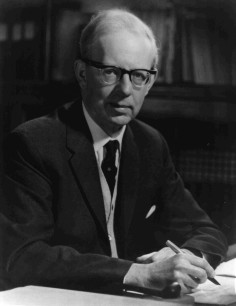Who was E.C. Stoner?
Edmund Clifton Stoner (1899-1968)
 E C Stoner was an extremely distinguished and brilliant Theoretical Physicist after whom the building housing the Department of Physics and Astronomy at Leeds is now named. He is principally known for his outstanding work on the origin and nature of magnetism but his early work on the distribution of electrons among atomic levels in 1924 was also remarkable. At this time the modern theory of quantum mechanics had not been discovered. Stoner's inductive findings became later encapsulated in the quantum mechanical Pauli exclusion principle for which Pauli received the Nobel Prize. In addition he had a lifelong interest in Astrophysics and discovered, in 1932, the maximum or limiting mass of a white dwarf star. It is entirely appropriate that the Department is named after Stoner. There is much continuing work at Leeds on the vast subject of magnetism. Stoner also published an early paper on the origin of cosmic rays and this again is an area where Leeds is in the forefront of international research.
E C Stoner was an extremely distinguished and brilliant Theoretical Physicist after whom the building housing the Department of Physics and Astronomy at Leeds is now named. He is principally known for his outstanding work on the origin and nature of magnetism but his early work on the distribution of electrons among atomic levels in 1924 was also remarkable. At this time the modern theory of quantum mechanics had not been discovered. Stoner's inductive findings became later encapsulated in the quantum mechanical Pauli exclusion principle for which Pauli received the Nobel Prize. In addition he had a lifelong interest in Astrophysics and discovered, in 1932, the maximum or limiting mass of a white dwarf star. It is entirely appropriate that the Department is named after Stoner. There is much continuing work at Leeds on the vast subject of magnetism. Stoner also published an early paper on the origin of cosmic rays and this again is an area where Leeds is in the forefront of international research.
Stoner was born in 1899 in the district of Esher in Surrey. His father, Arthur Hallett Stoner, married his mother, Mary Ann Fleet, in 1898 and neither came from wealthy families which is important in the light of his father's occupation and Stoner's schooling. His father seems to have been rather good at school but financial difficulties and the desire for an outdoor life led him into the precarious career of a professional cricketer. In 1907 he took eight wickets in a game against the South Africans while playing for Durham! However, the point is that E C Stoner was constantly moving from school to school finally finishing up winning a scholarship to Bolton Grammar School from where he won scholarships which took him to Cambridge in 1918. Throughout his life he suffered from ill health which precluded from sporting pursuits but he developed deep interests in music and writing. Later on in his life while crossing the Atlantic by ocean liner he acted as the pianist for the ship's concerts!
After gaining a First Class degree in Cambridge Stoner began research work as an experimentalist working on thermionic valves with Lord Rutherford as his 'official' supervisor. He was most appreciative of Rutherford's kindness to him but made the observation, "He could be genially complimentary when manifest progress was being made. When things were going badly, however, he could make the most devastating comments in his naturally loud voice which could be heard far away". Fortunately Stoner with his work on electronic structure evolved into a theoretician (with the help of R H Fowler - Rutherford's son-in-law). At Cambridge his musical talents flourished and he wrote a song (to the tune of a song by Gilbert and Sullivan) which began
'Since J J on the game began
by analysing Neon
Many a man had thoughts which ran
Beyond a paper's rightful span.
So did we all agree on.
This was sung at Sir John Joseph Thomson's seventieth birthday.
Stoner came to Leeds in 1932 and was rapidly promoted to the Chair of Theoretical Physics in 1939 during which time his great work on magnetism was carried out. Strangely enough, Stoner had received no formal training in Mathematics at Cambridge yet was able to formulate the collective (or itinerant) electron theory of ferromagnetism for which he is famous. Later in 1949 he refined the theory with the later Peter Wohlfarth (who had come to Leeds from Bingley Grammar School). His work on magnetism also extended to practical applications. During the war years it was necessary to develop high coercivity magnetic materials for magnetrons and he carried out important work with Wohlfarth and Rhodes on ferromagnetic domains.
Edmund Clifton Stoner's life is a shining example of what can be achieved without the advantage of inherited wealth and how physical disabilities can be overcome with courage.
G.J. Morgan, 1999
